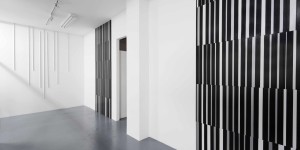[ February 3rd – 20th ]
With Raymond Carter’s Taper, Five Walls Gallery continues its impressive calendar of shows showcasing Australia’s non-objective and neo-concrete artists. This is Carter’s second solo exhibition here and it continues his applied investigation of formalist aesthetics. A highly skilled lino-cut printmaker, Carter’s realignment of practice to one incorporating the deceptively simple component of pure line was a direct result of his recent candidature in the Victorian College of the Arts Master of Contemporary Arts Program. In short, he is now – ironically – a re-emerging artist of many years standing. What this also means is that whilst there is an undeniable freshness to his current work, it is underscored by decades of disciplined technique.
The formalist (as opposed to modernist) agenda has witnessed a major renewal since the turn of the millennium though, like painting, formalism never truly died. It has proven to be a surprisingly robust conceptual attitude concerned with the materiality of objects and their visual aspects whilst emphasizing compositional elements such as colour, line, shape and texture. With a nod to the industrial aesthetic of Donald Judd, Carter’s favoured material is hardware-bought coloured adhesive cloth tape applied to MDF. Although he claims he first employed tape ‘because it was there, cheap, fast and handy’, Carter has since developed a discerning understanding of its strength as an artistic medium. He adds: ‘the pace of production has (also) allowed me to experiment and produce many different solutions quickly.’ This was particularly evident in his spectacular wall of nearly 200 panels shown at the Victorian College of the Arts in 2014, a kaleidoscopic parade of colour and line.
At Five Walls, two large multi-paneled works hang either side of the passage leading to the gallery’s rear studios and Carter’s palette is pared back to basic black, silver and white. The austerity of his lines activates an optical flicker between the stripes which conversely emphasises their entirety as continuous structural elements. What causes this flicker is a combination of innate impulses within the eye. When reacting visually to artworks such as these, the narrowest lines perceived fall closest to the limits that an eye can actually lock on to a particular line’s edge. If the stripes are also of variable widths then the eye has increased difficulty discerning exactly where any true edges are. Additionally, eyes naturally scan all over images and shudder continuously at frequencies between 4 and 50 hertz. Combined, this means the eye has its own set or parameters of what it is capable of discerning clearly. If positional cues are NOT doing what the eye expects, then the optical flicker begins.
For the pieces in Taper, Carter first applies a central line to the initial panel and then responds intuitively with each consecutive stripe using an almost haptic judgment as to their relative thickness and length. As outlined above, the finished pieces resonate with optic vibration and their hanging position suggests meditative panels placed either side of a sanctuary’s entrance, portents of deeper mysteries that may be revealed beyond the gallery’s walls. Attached to the adjacent walls are two low-relief sculptural installations made from extruded aluminium, created on site as dedicated counterpoints to the extant multi-paneled works. As before, Carter reacts to the developing dynamic of the components, playing with the physicality of the materials whilst responding to the opposition between form and ground, as well as to the tension between what is artwork and what is ‘real’ space. Thus, the gallery as a whole has a perceptible hum which allows the viewer a truly immersive experience.
Andrew Gaynor, 2016









